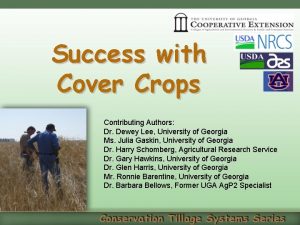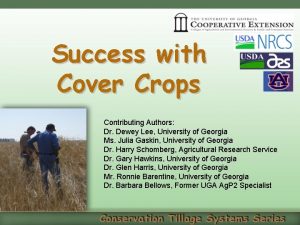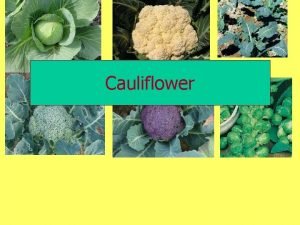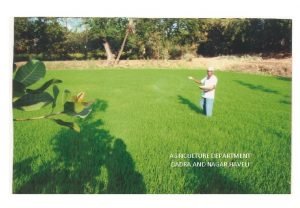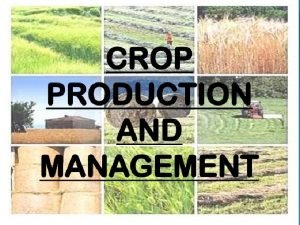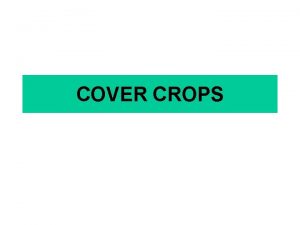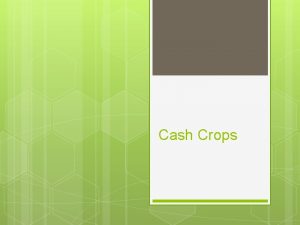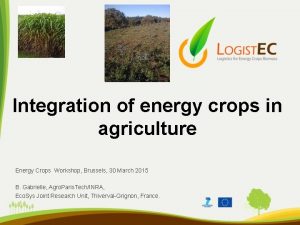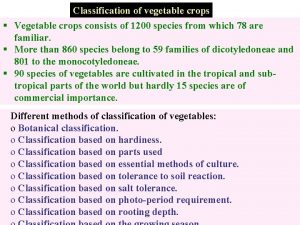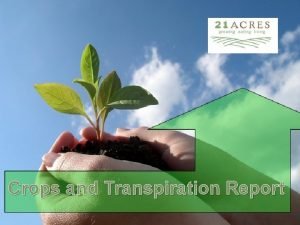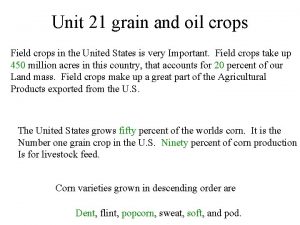Cover Crops What Are Cover Crops A cover











- Slides: 11

Cover Crops

What Are Cover Crops? A cover crop is any plant that has been seeded in addition to a cash crop in order to gain environmental and economic benefits. One of the main goals of cover crops in Iowa is to protect the soil when corn and soybeans are not actively growing on the landscape. Cereal rye cover crop growing into no-till corn in Carrol County, Iowa. NRCS/SWCS photo by Lynn Betts.

Why Use Cover Crops? In a typical corn–soybean rotation, there are only living roots in the ground four to five months out of the year. Fall and spring rains often arrive in Iowa when there are no living roots on agricultural fields, leading to nitratenitrogen being washed away. Cover crops provide living roots during this time of year. These roots absorb nitrate-nitrogen and prevent it from being lost. NRCS/SWCS photos by Lynn Betts.

What Can Cover Crops Do for Water Quality? According to Iowa’s Nutrient Reduction Strategy, cereal rye and oat cover crops, when included in a corn–soybean rotation, have the potential to reduce average nitratenitrogen loss by 31% and 28%, respectively. A cereal rye cover crop has the potential to decrease phosphorus loss by 29% according to the same report. Top: Cereal rye cover crop on no-till ground in Washington County, Iowa. Bottom: Water from tile lines being tested for nitrate-nitrogen. NRCS/SWCS photos by Lynn Betts.

Benefits of Cover Crops • • • Decrease soil erosion Increase soil microbial activity (soil health) Decrease nutrient runoff and leaching Increase soil carbon Suppress weeds Improve soil structure (increased infiltration, decreased compaction, increased water holding capacity) Manage soil moisture Provide habitat for beneficial insects, pollinators, and wildlife Provide forage for farm animals Break disease cycles Interseeded radish, annual ryegrass and clover crops into corn in Tama County, Iowa. Cereal rye being harvested for seed in Carrol County, Iowa. Annual ryegrass’s dense but shallow rootmass. All NRCS/SWCS photos by Lynn Betts.

What Is the Cost of Cover Crops? Cover crops cost about $25 to $30 per acre. Funds are available from Iowa Department of Agriculture and Land Stewardship through their Water Quality Initiative and State Cost-Share. The Natural Resources Conservation Service has Environmental Quality Incentives Program (EQIP) and Regional Conservation Partnership Program (RCPP) funds available. Cereal rye cover crop in Washington County, Iowa. NRCS/SWCS photo by Lynn Betts.

Types of Cover Crops: Rye Cereal rye is Iowa’s most common and most successful cover crop. Rye is a winter hardy grain that is planted in the fall, overwinters, and then grows in the spring. It provides valuable protection for the soil during spring rains, before being terminated with herbicide ahead of corn or soybeans. Benefits: Reliable establishment and overwintering, erosion control, and nutrient loss reduction Limitations: Can become a weed if tilled at the wrong time Cereal rye cover crop in Buena Vista County, Iowa. NRCS/SWCS photo by Lynn Betts.

Types of Cover Crops: Radishes are recommended for more experienced cover croppers. They work best in Iowa if used in a mix and established by Labor Day. This is typically done following the harvesting of a small grain crop in July. Radish does not overwinter, but some farmers use it in a mix as fall/winter forage. Benefits: Decreases compaction, suppresses weeds, and scavenges nitrogen Limitations: Diverse spectrum of traits depending on variety, expensive seeds, and low tolerance for wet soils Interseeded radish, annual ryegrass, and clover in corn in Tama County, Iowa. NRCS/SWCS photo by Lynn Betts.

Grazing Cover Crops Livestock can graze cover crops in the fall, winter, or spring. Benefits can include decreasing feed costs and/or “mowing” cover crops in preparation for cash crops. Cattle grazing or “mowing” cereal rye ahead of planting in Sac County, Iowa. NRCS/SWCS photos by Lynn Betts.

Other Resources • • • https: //www. flickr. com/photos/151012306@N 08/albums/72157672351331508: A step by step visual guide to cover crop implementation. These photos were taken on real farms across Iowa and are part of the Conservation Media Library. https: //vimeo. com/290520999: A video about cover crop implementation in Iowa that is part of the Conservation Media Library. http: //www. sare. org/Learning-Center/Topic-Rooms/Cover-Crops: General benefits of cover crops and the different management systems they can be incorporated into from Sustainable Agriculture Resource and Education (SARE). Includes descriptions of different cover crop varieties as well as how to select and manage them. http: //www. practicalfarmers. org/member-priorities/cover-crops/: From Practical Farmers of Iowa (PFI), links to many different Iowa-focused cover crops resources (including a list of businesses that can supply seeds and custom planting) and access to Practical Farmers of Iowa on-farm research trials. https: //www. nrcs. usda. gov/Internet/FSE_DOCUMENTS/nrcs 142 p 2_005818. pdf: A general factsheet on cover crops in Iowa from the Natural Resources Conservation Service. http: //www. mccc. msu. edu/: A one stop shop for all things cover crops from the Midwest Cover Crop Council.

This presentation is part of the Conservation Media Library. To learn more about it and access other resources, go to www. swcs. org. The Library was supported by an Iowa NRCS funded Conservation Innovation Grant to the Soil and Water Conservation Society and Conservation Districts of Iowa.
 Insidan region jh
Insidan region jh Cover crops
Cover crops Cover crops
Cover crops Harmonious arc
Harmonious arc Heterophoria vs heterotropia
Heterophoria vs heterotropia Intermittent exotropia
Intermittent exotropia High responder crops of the green revolution
High responder crops of the green revolution Cole crops definition
Cole crops definition Genetically modified crops have
Genetically modified crops have If we had more rain our crops would grow faster
If we had more rain our crops would grow faster Dadra and nagar haveli agriculture
Dadra and nagar haveli agriculture Kharif crops examples
Kharif crops examples

